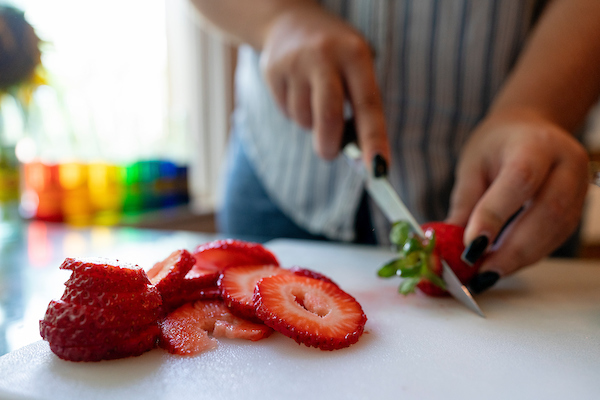Russell Wallace, Ph.D., wrote the book on Texas strawberry production.
When it comes to the newly updated 132-page guide for Texas strawberry production, Wallace, a Texas A&M AgriLife Extension Service horticulturist in the Texas A&M Department of Horticultural Sciences, Lubbock, would be the first to mention the long list of contributors. Growers across the state, research colleagues and AgriLife Extension county agents all made significant contributions to the science behind the book.
But it was the time, effort, miles and sometimes money Wallace invested that kept statewide strawberry research moving forward.

After 22-and-a-half years in horticulture science and outreach, Wallace is retiring, but he’s leaving Texas A&M AgriLife at an opportune time for the agency and him personally. He’s retiring to spend more time with family, including 10 grandchildren; and he’s completed the “Commercial Strawberry Field Production in Texas” guide, which has been his own “baby” of sorts the past several years.
“I’ve been fortunate to do work that I love, and that had purpose beyond me,” he said. “I’ve traveled thousands of miles in Texas and developed a lot of relationships with growers, some of whom are my good friends. But I’d like to see my grandkids and family more, and that’s a good reason to hang it up.”
Rocky start for Texas strawberry science
Wallace was an AgriLife Extension vegetable specialist for more than a decade before he began working on strawberries. His 75% extension, 25% research appointment led to a range of research trials, including weed and pest control studies for many vegetable crops, primarily on the Texas High Plains.
In 2010, Wallace collaborated on a multi-state U.S. Department of Agriculture, USDA, grant-funded trial focused on testing high tunnel production systems to grow high value crops like tomatoes, lettuce and strawberries.
Wallace doubted strawberries could be a viable crop in Lubbock before his experimental program started. But he was convinced by other researchers to at least try the crop under the experimental hoop-house-style high tunnel structures.
“My first year was a complete crop failure because we followed instructions that were not good for our locations,” he said. “But over the next several years, we learned how to plant and how to manage them, and strawberry production skyrocketed as we learned.”
Texas strawberry research takes root
In 2014, several of his strawberry grants ended, and Wallace found himself in a funding predicament. The trials had shown great promise but there was no money to continue strawberry research.
He decided to, much to his wife’s displeasure, tap what he called “the Wallace Foundation” for money. With personal funds and help from a handful of local farmers, the research continued for that year.
He paid the help and his wife in strawberries.
“We were at a pivotal point when those grants ended,” he said. “We were learning a lot and had some good preliminary data, and so we committed and conducted more trials. But a lot of that foundational data is what we needed to submit for more grants, and it kept the Texas strawberry research alive.”
Wallace said excellent collaborators and faculty and supportive bosses made the research and outreach parts of his job fun. Working with Texas growers, getting to know them, learning alongside them and providing science-based data on crops in his AgriLife Extension capacity has been the part of the job he’s enjoyed the most.
“The growers are a unique group,” he said. “They farm independently, but they are cohesive in that they want each other to succeed. Most share information, and they encourage more growers to jump into strawberry production.”


Texas strawberry production progress
Wallace hopes the work he’s done helps Texas reestablish itself as a strawberry state. It’s already provided positive momentum.
“There is definitely a deficit in the state when it comes to locally grown strawberries,” he said. “Any grower who really dives into it can sell all the strawberries they produce and at great prices.”
According to Wallace’s research, the first commercial strawberry acres in Texas were planted in 1874. By 1930, Texas had more than 3,000 strawberry acres. Strawberries remained prominent horticultural fixtures in places like Poteet and the Houston area, but acreage slipped to nearly nothing until recently.
Wallace said there were around 150 acres in the state when he began his research. Now, there are an estimated 400-500 strawberry acres.
Strawberry growers in Texas primarily market directly to consumers as “pick-your-own,” or via farmers markets and fruit stands while a few also sell to regional grocers. Direct-to-consumer sales help maximize income, which is important because growing strawberries is expensive.
Wallace’s research has helped increase strawberry plant productivity. His recommendations, whether related to soil pH levels, weed control, fertilization, irrigation or the strawberry varieties that perform best across a state with such diverse climates and soils, have helped guide growers toward success.
A typical strawberry field holds around 17,000 plants that produce on average between one-half and three-quarters of a pound of fruit, or 8,500 to 17,750 pounds per field. Some growers and varieties are producing 1 pound of fruit per plant or better, Wallace said.
“The progress in Texas has been phenomenal,” he said. “It’s a testament to everyone involved from the growers to our specialists and staff. There’s a lot of risk involved for the growers and money to invest before they see their first strawberry. I’ve always kept that in mind and geared my efforts toward their success. Hopefully, I’ve been able to do that.”





